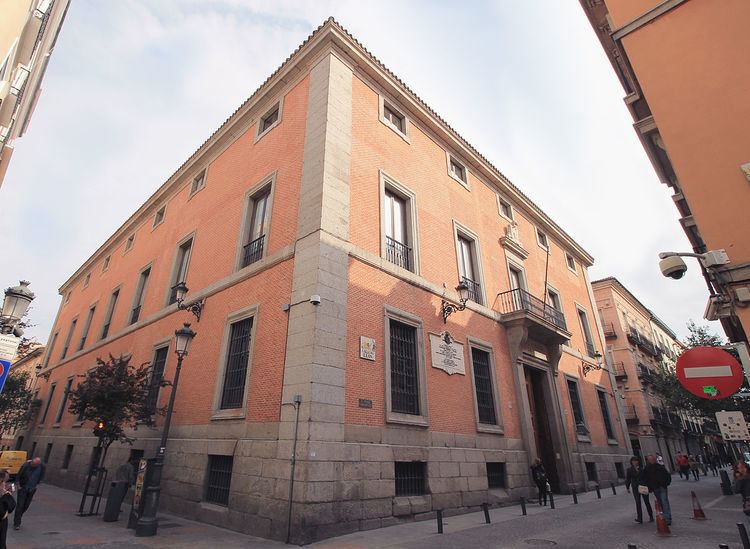Location Madrid, Spain Criteria Monument Reference no. RI-51-0001170 Phone +34 914 29 06 11 | Type Non-movable Designated 1945 Province Community of Madrid | |
 | ||
Address Calle del León, 21, 28014 Madrid, Spain Hours Closed today SaturdayClosedSundayClosedMonday8:30AM–3:30PMTuesday8:30AM–3:30PMWednesday8:30AM–3:30PMThursday8:30AM–3:30PMFriday8:30AM–3:30PMSuggest an edit Similar Real Academia de Bellas, National Library of Spain, National Archaeological Museum, General Archive of the Indies, Castile | ||
Real Academia de la Historia (English: Royal Academy of History) is a Spanish institution based in Madrid that studies history "ancient and modern, political, civil, ecclesiastical, military, scientific, of letters and arts, that is to say, the different branches of life, of civilisation, and of the culture of the Spanish people".
Contents
- Carmen sanz ay n miembro de la real academia de la historia
- Collections
- Criticism
- Biographical dictionary
- Metro collaboration
- Members
- Academic Correspondents
- References
The Academy was established in 1738. Since 1836 it has occupied an 18th-century building designed by the neoclassical architect Juan de Villanueva. The building, which was originally occupied by the Hieronymites, had become available as a result of the Ecclesiastical confiscations of Mendizábal.
Carmen sanz ay n miembro de la real academia de la historia
Collections
As formerly the main Spanish institution for antiquaries, the Academy retains significant libraries and collections of antiquities, which cannot be seen by the public. The keeper of antiquities is the prehistorian Martín Almagro Gorbea.
Items held include:
Criticism
Some Spanish historians have considered it an obsolete misogynist institution, that still considers history as a matter of kings and battles. However, the image has changed since Gonzalo Anes was director.
Biographical dictionary
In 2011 the Academy published the first 20 volumes of a dictionary of national biography, the Diccionario Biográfico Español, to which some five thousand historians contributed. The publicly funded publication has been subject of controversy for failing to achieve the standards of objectivity associated with, for example, the Oxford Dictionary of National Biography. The British Dictionary restricted itself to persons who were deceased, and the historian Henry Kamen has argued that it was a mistake for its Spanish equivalent to include living figures among entries. However, while there was criticism of entries for some living people (such as the politician Esperanza Aguirre), the main allegations of bias concern articles relating to Francoist Spain. A notable example is the entry on Francisco Franco, written by Luis Suárez Fernández, in which Franco is defined as an autocratic head of state rather than a dictator. In contrast, the administration of the democratically elected President Negrín is described as dictatorial.
The dictionary sparked an outcry. Most objections came from voices on the left such as the party United Left and the newspaper Público. For his part, Green party senator Joan Saura asked for publication of the dictionary to be stopped and the offending volumes withdrawn. There was also a call for corrections from the Ministry of Education. The Academy announced in June 2011 that amendments would be made to the text on line and in future paper editions. In 2012, when the Minister of Education, Culture and Sport, made a statement on the subject of the dictionary, it was still not clear whether the Academy was willing to describe Franco as a dictator. However, by 2015 with Carmen Iglesias as director, the situation had changed.
Metro collaboration
In 2015 the Academy entered into an initiative in collaboration with Metro de Madrid to provide information about people who have given their names to metro stations.
Members
The Real Academia de la Historia is composed of 36 members, with Academic Correspondents covering all the provinces of Spain and the rest of the world, taking the actual number to 370 (2006). The Director since 2014 has been Carmen Iglesias.
The members of the Academy are (after the number of chair):
- Vicente Pérez Moreda
- Hugo O'Donnell y Duque de Estrada
- Francisco Rodríguez Adrados
- Luis Suárez Fernández
- Feliciano Barrios Pintado
- Vacant
- Josefina Gómez Mendoza
- José Remesal Rodríguez
- María del Pilar León-Castro Alonso
- Luis Miguel Enciso Recio
- Martín Almagro Gorbea
- Carlos Seco Serrano
- Vacant
- Francisco Javier Puerto Sarmiento
- Juan Pablo Fusi Aizpurúa
- Antonio Cañizares Llovera
- José Alcalá-Zamora y Queipo de Llano
- José Antonio Escudero López
- Luis Antonio Ribot García
- Fernando Díaz Esteban
- José Ángel Sesma Muñoz
- Enriqueta Vila Vilar
- María del Carmen Iglesias Cano
- Fernando Marías Franco
- Miguel Ángel Ladero Quesada
- Serafín Fanjul García
- Miguel Ángel Ochoa Brun
- Luis Alberto de Cuenca y Prado
- José Luis Díez García
- Carmen Sanz Ayán
- Faustino Menéndez Pidal de Navascués
- Carlos Martínez Shaw
- María Jesús Viguera Molins
- Miguel Artola Gallego
- Vacant
- Luis Agustín García Moreno
Academic Correspondents
Notable Academic Correspondents of the Academy include:
